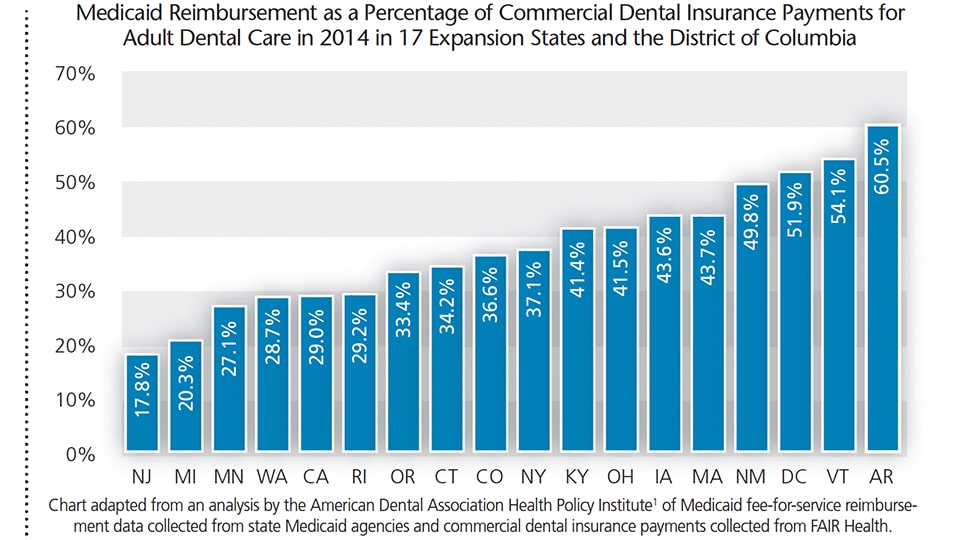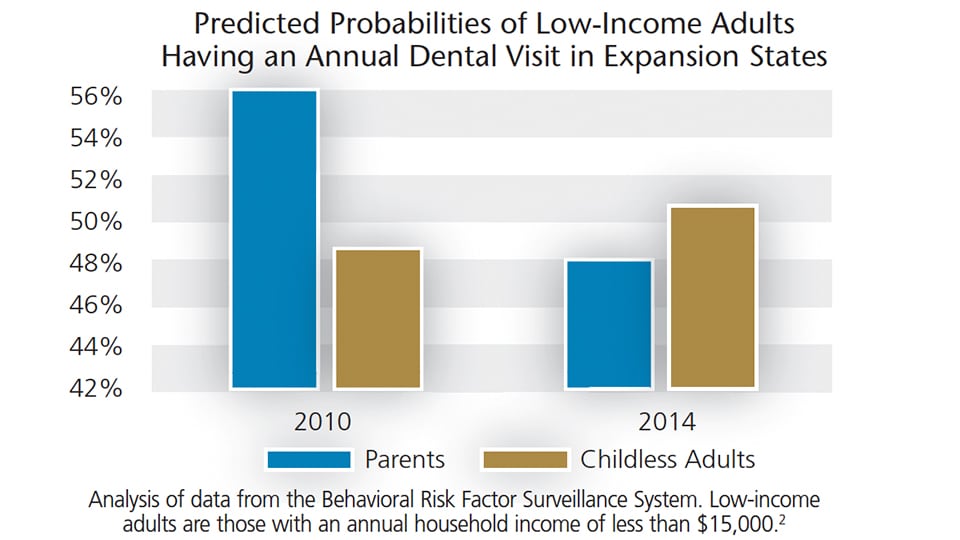Medicaid’s Role in Expanding Dental Capacity
When the Affordable Care Act (ACA) expanded Medicaid coverage to adults with incomes below 138% of the federal poverty level, 17 states and the District of Columbia included the optional adult dental benefit (beyond emergency services) in their Medicaid coverage.
When the Affordable Care Act (ACA) expanded Medicaid coverage to adults with incomes below 138% of the federal poverty level, 17 states and the District of Columbia included the optional adult dental benefit (beyond emergency services) in their Medicaid coverage. For dentists in these states, this represents a potential new group of patients — but it’s not a particularly well-paying group. Medicaid adult dental payments are substantially lower than private dental benefits, ranging from a high of 60.5% of commercial payments in Arkansas to a low of 17.8% in New Jersey.1 Consequently, not all dentists will accept Medicaid patients.
This could be what’s behind some puzzling results from a recent study in Health Affairs. The authors examined the impact of expanding Medicaid benefits on the use of dental care among low-income adults. The expectation was that newly covered individuals would use their benefits and visits would increase. What investigators found, however, was that while visits increased among childless adults, visits decreased among parents.2
Why would expansion of Medicaid dental benefits reduce the number of adults with children who went to the dentist? Looking closer, the researchers realized that in many of the expansion states, parents actually had Medicaid dental coverage prior to passage of the ACA. They theorized the decline in visits among parents could be due to this cohort being crowded out by the more numerous group of low-income childless adults who now had Medicaid dental benefits too.
Research has shown that when Medicaid adult dental benefits are added, dentists are able to expand their capacity to take on new patients.3 But in order to adequately serve all the new Medicaid patients, there needs to be greater financial motivation to do so. Or, as the authors of the Health Affairs study put it, “Medicaid adult dental coverage is necessary, but not sufficient by itself to improve access to dental care among low-income nonelderly adults.”
REFERENCES
- Nasseh K, Vujicic M, Yarbrough C. A Ten-Year, State-by-State, Analysis of Medicaid Fee-for-Service Reimbursement Rates for Dental Care Services. Available at: ada.org/en/~/media/ADA/Science%20and%20Research/HPI/Files/HPIBrief_1014_3. Accessed April 25, 2017.
- Singhal A, Damiano P, Sabik L. Medicaid adult dental benefits increase use of dental care, but impact of expansion on dental services use was mixed. Health Aff. 2017;36:723–732.
- Buchmueller TC, Miller S, Vujicic M. How Do Providers Respond to Public Health Insurance Expansions? Evidence From Adult Medicaid Dental Benefits. Available at: nber.org/papers/w20053. Accessed April 25, 2017.
From Decisions in Dentistry. May 2017;3(5):60.




